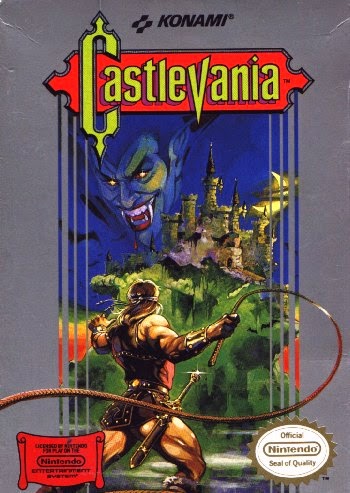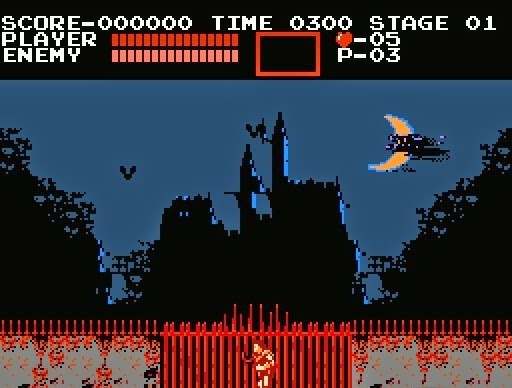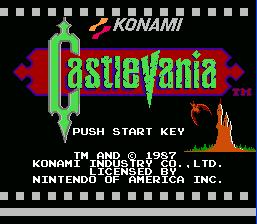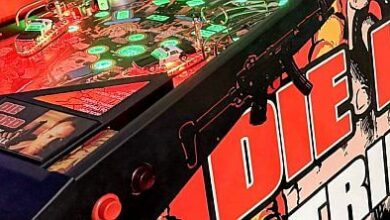“Blinge” Cataldo
If somebody were to name the most famous 2D platformer franchise, the most
common responses would be Mario Bros, Sonic the Hedgehog or maybe Megaman. Lurking
just outside the window however is Castlevania, one of the oldest series still
enjoying new releases today. The original Castlevania was released by Konami on
the Nintendo Entertainment System in 1987.
Castlevania you assume the role of Simon Belmont, a hero of the Belmont clan of
vampire hunters. You have a simple mission; battle your way into Castle Dracula
and kill its owner. Although he’s Dracula in all but name as the manual simply
refers to him as “The Count.”
was one of the first horror themed console games and achieves this end
beautifully. While earlier NES games often looked more primitive than their
later 8-bit counterparts, Castlevania remains visually impressive, showing
variation in each stage despite the entire game taking place within the castle
itself. The NES’ colour palette is used tastefully, the backgrounds are
detailed enough to avoid being repetitive and the foreground elements pop out
enough to be distinct from the backdrop.

progresses through the castle he encounters new themes in each stage. First, a
zombie infested entrance, an ascent through crumbling stairs and hallways, a
race across rooftop parapets, an underground cavern, a grim laboratory and
finally the iconic clock tower that has since become a staple of the series.
The whole game is replete with gothic imagery and these surroundings are
suitably aged as to look like a still-living ruin: the castle itself seems
undead.
Indeed the place is teeming with un-life, packed
with monsters that aren’t exclusively from the vampire mythos. Castle Dracula
is described as a “doss house for every monster from every mythology
ever” by notorious reviewer Yahtzee Croshaw.
Castlevania
arrived on the NES amid a total saturation of 2D scrolling games, but what
distinguishes Konami’s flagship platformer was its slower pace. Belmont can’t
jump on enemies to kill them, neither is he fast enough to avoid the castle
denizens, even attempts to jump over enemies will likely cause him damage.
Slamming into a crowd of enemies to try and force your way will often lead to
death as well. The player is encouraged to take each new enemy or obstacle as
its own challenge, whether by using the range of Belmont’s whip, or by
experimenting with the various secondary weapons you can find in the castle.

great example of this is the throwing axe, which can be found shortly before
the first boss – a large vampire bat. The bat usually stays above Belmont
before swooping down to attack: while it’s possible to whip it during this dive
attack, using the axe and its upwards arc is a more reliable tactic. This is an
example of player training as the player should learn that using the different
sub-weapons yields better results.
pace contributes to player training again in stage 2 when you find a Bone
Pillar waiting at the top of a staircase. This static enemy stands in place
like a turret and repeatedly fires two projectiles at a slight interval, but
Belmont can safely stand on a lower step beneath the fireball’s trajectory. An
observant player should see the Pillar’s pattern of attack, and that it’s
possible to hit it safely with the whip from slightly below. Carrying this
knowledge into the rest of the game will make future Bone Pillars easier to
deal with, as will using the environment to gain an advantage over enemies,
thus a slower pace encourages intelligent play, and intelligent play is
rewarded. Let it be known however that rushing through Castlevania is possible,
as is only using the whip, though this requires a real mastery of the game.

and slower gameplay is also the main source of difficulty in Castlevania. While
a modern gamer may dismiss Belmont’s sluggish movement as old games having bad
controls; slower movement and lack of agility is integral to the balance of the
game, and the controls are precise enough to be suited for this purpose. It is
usually a player’s rash actions that get them killed rather than Belmont’s
speed.
source of difficulty is the much bemoaned knockback: upon being hit, Belmont
will be stunned for a fraction of a second and stagger backwards. Sometimes
this can be disastrous, you might be hit and knocked backwards into an instant
death-pit, or bounced between several enemies, taking a lot of damage in the
process. However there is a positive aspect to knockback: you’re invincible for
the duration of the stun period and slightly longer, saving you from taking
fatal levels of damage too quickly and in the second scenario mentioned above,
it would be possible to jump to safety or launch a counterattack.
Standard
practice for many games at this time was to give the player a limited number of
lives and continues; once they’re gone it’s game over. Castlevania offered a
concession here as you can continue infinitely from the beginning of the stage
you’re on. Stages are made up of smaller sub-areas, dying resets you to the
beginning of an area (with 0 ammunition) and continuing after a game-over takes
you back to the first area of that stage.
difficulty, this is a good system that rewards progress and encourages the
player to continue without fear of losing that progress.
Overcoming
frustration and learning how to deal with a difficult section to the point
where you can beat it every time and progress further is an immensely rewarding
experience, it’s what makes Castlevania such a good game and the essence of why
we enjoy challenging experiences.
Castlevania’s atmosphere is a fusion of the 2D action game with gothic spookiness,
so it can’t be called a pure horror game, despite drawing upon gothic imagery
throughout. However, encouraging a new player to take things slowly provides
ample time to build some measure of suspense. Music plays a huge part in
creating the game’s atmosphere; the brief intro builds tension as Belmont
approaches the castle gate, before giving way to the opening blast of Vampire Killer, the catchy and iconic
level 1 song. The theme of the whole game is summed up here: a foreboding build
up, then straight into the action. In keeping with the gothic atmosphere, the
boss theme sounds like classical music through the NES soundchip, which works
surprisingly well. That same boss melody is worked into the stage 5 music, Heart of Fire: the perfect example of
the feel of a classic Castlevania game.
soundtrack does go for a full horror approach when Belmont finally reaches
Dracula himself, the final ascent up a long staircase into the Count’s throne
room with the music constantly cranking up the tension must have been
mind-blowing for somebody playing it for the first time in 1987. The fact that
many of these songs have been re-used and rearranged in later games in the
series is a testament to the quality of their composition and their popularity
among fans.

The NES revolution brought something that console gaming hadn’t seen before;
the ability to pick a theme and run with it, fashioning a coherent gaming
experience from that theme. Castlevania does this with gothic horror, it does
it with spooky imagery and sounds but doesn’t detract from the fun of a
platformer/action game. The gameplay itself even feeds into that theme by
encouraging the player to take their time and think about how they’ll tackle
each challenge. Many design elements in modern games can be traced back to this
pioneering time, or Castlevania itself. One could go as far as to suggest that
this game was the Dark Souls of its time.
Come then ye children of the night, those vampires aren’t gonna slay
themselves.
This extended review by Ben “Blinge” Cataldo
Also the web review can be found here:





